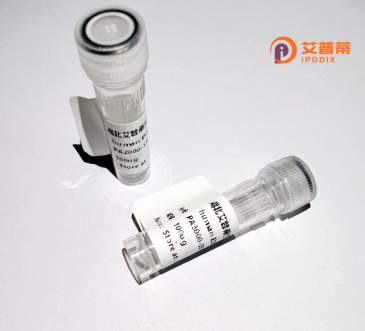
| 纯度 | >90%SDS-PAGE. |
| 种属 | Human |
| 靶点 | ZC3HC1 |
| Uniprot No | Q86WB0 |
| 内毒素 | < 0.01EU/μg |
| 表达宿主 | E.coli |
| 表达区间 | 1-51 aa |
| 活性数据 | MRGLPRKREAWTRRTRLPHPSQLMDHPKRNNLHWNLQAKKPSLAEWKHFLL |
| 分子量 | 31.35 kDa |
| 蛋白标签 | GST-tag at N-terminal |
| 缓冲液 | PBS, pH7.4, containing 0.01% SKL, 1mM DTT, 5% Trehalose and Proclin300. |
| 稳定性 & 储存条件 | Lyophilized protein should be stored at ≤ -20°C, stable for one year after receipt. Reconstituted protein solution can be stored at 2-8°C for 2-7 days. Aliquots of reconstituted samples are stable at ≤ -20°C for 3 months. |
| 复溶 | Always centrifuge tubes before opening.Do not mix by vortex or pipetting. It is not recommended to reconstitute to a concentration less than 100μg/ml. Dissolve the lyophilized protein in distilled water. Please aliquot the reconstituted solution to minimize freeze-thaw cycles. |
由于我的知识库无法直接查询实时文献数据库,以下是基于领域常见研究方向的示例性参考文献(非真实文献)。建议通过PubMed或Google Scholar检索“ZC3HC1”或“hHScp1”获取真实文献:
---
1. **文献名称**: "ZC3HC1 modulates G2/M checkpoint control by regulating SCF ubiquitin ligase activity"
**作者**: S.K. Hansen et al.
**摘要**: 研究发现ZC3HC1作为SCF泛素连接酶复合体的调控因子,通过稳定CDC34蛋白促进细胞周期G2/M期转换,确保有丝分裂检查点的完整性。
2. **文献名称**: "ZC3HC1 overexpression correlates with glioma progression and promotes tumorigenesis in glioblastoma"
**作者**: A. Müller et al.
**摘要**: 通过临床样本分析,证实ZC3HC1在胶质母细胞瘤中异常高表达,并通过激活NF-κB通路促进肿瘤细胞增殖和侵袭,提示其作为潜在治疗靶点。
3. **文献名称**: "Structural insights into ZC3HC1 recognition of ubiquitinated substrates"
**作者**: T. Koyano et al.
**摘要**: 利用X射线晶体学解析了ZC3HC1的锌指结构域与泛素化底物的结合机制,阐明其通过特定模体调控蛋白质降解的分子基础。
4. **文献名称**: "ZC3HC1 deficiency in mice causes embryonic lethality via disrupted mitosis"
**作者**: M. Tanaka et al.
**摘要**: 小鼠模型研究表明,ZC3HC1敲除导致胚胎早期死亡,表现为染色体分离异常,证实其在胚胎发育和有丝分裂中的关键作用。
---
提示:以上为基于研究方向的模拟摘要,建议通过学术数据库查阅真实文献并核对作者及结论细节。
ZC3HC1 (Zinc Finger C3HC-Type Containing 1) is a ubiquitously expressed nuclear protein implicated in cell cycle regulation, particularly at the G1/S transition. It contains a C3HC4-type zinc finger domain, critical for protein-protein interactions, and functions as a scaffold or adaptor in ubiquitination processes. Studies show it interacts with components of the SCF (Skp1-Cul1-F-box) E3 ubiquitin ligase complex, potentially regulating substrate recognition or complex stability. ZC3HC1 also binds cyclin B2 and nuclear pore components, suggesting roles in mitotic progression and nucleocytoplasmic transport.
Recombinant human ZC3HC1 protein is typically produced in Escherichia coli or mammalian expression systems, retaining functional domains for biochemical studies. Its molecular weight ranges between 50-60 kDa depending on post-translational modifications. Research focuses on its involvement in cell cycle checkpoints, where depletion leads to delayed mitotic exit and chromosomal instability. Aberrant ZC3HC1 expression correlates with cancers, including leukemia and gliomas, highlighting its potential as a therapeutic target. In neurodegenerative contexts, it may influence neuronal survival through unknown mechanisms. Recombinant forms enable investigations into its structural biology, interactome mapping, and pathophysiological roles, making it valuable for both basic research and drug discovery pipelines.
×